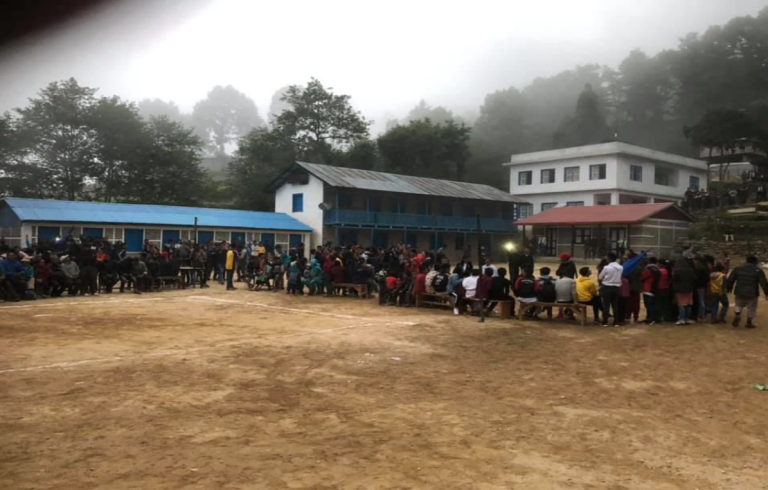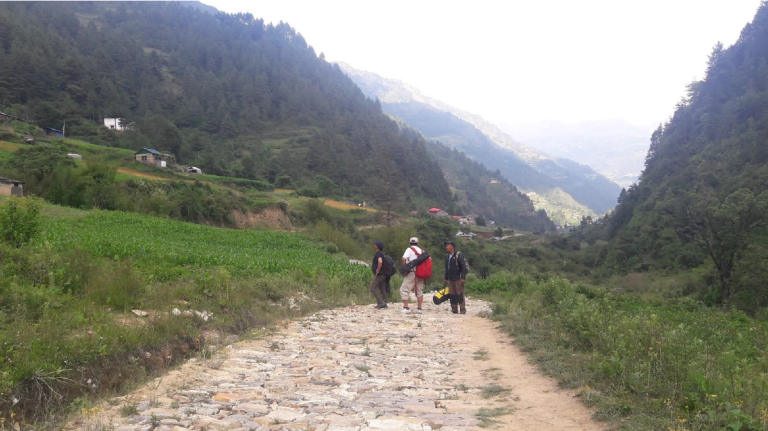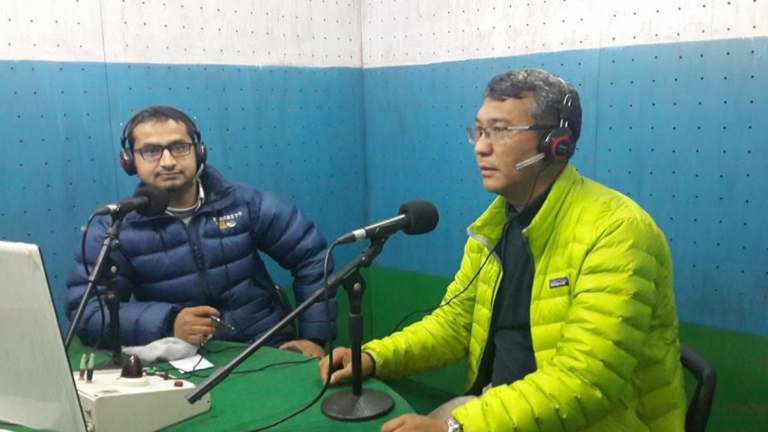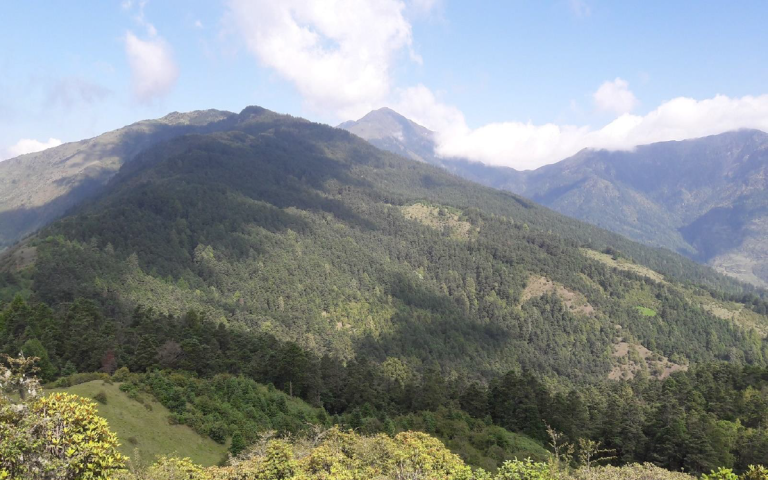Biodiversity conservation, sustainable land use practices, agroforestry, community-based conservation, ecotourism, and the challenges faced in promoting sustainable development in the Solukhumbu region of Nepal
26.05.2023
SUBMITTING ORGANIZATION
OTHER CONTRIBUTING ORGANIZATIONS
High Himalayan Agriculture Farm
DATE OF SUBMISSION
15/04/2023
REGION
Asia
COUNTRY
Nepal
KEYWORDS
socio-ecological production landscapes and seascapes (SEPLS), IPSI case studies, knowledge sharing, sustainability, biodiversity
AUTHORS
Ngwang Sonam Sherpa
Summary Sheet
The summary sheet for this case study is available here.
Introduction
Biodiversity conservation, sustainable land use practices, agroforestry, community-based conservation, ecotourism, and the challenges faced in promoting sustainable development in the Solukhumbu region of Nepal.
Biodiversity conservation, sustainable land use practices, agroforestry, community-based conservation, ecotourism, and the challenges faced in promoting sustainable development in the Solukhumbu region of Nepal are the main topics of discussion.
Solukhumbu, located in the Himalayan region of Nepal, is a region that boasts unique biodiversity and cultural heritage. The area is home to rich biological diversity, with over 1,300 species of flowering plants, 40 species of rhododendrons, and various medicinal plants. The region is also home to rare and endangered species such as the snow leopard, red panda, Himalayan tahr and musk deer. Additionally, Solukhumbu is home to Mount Everest, the highest peak in the world, and many UNESCO World Heritage sites. Despite its ecological significance, the region faces several challenges, including climate change, habitat loss, and unsustainable land use practices.
To tackle these challenges, the Nepal Indigenous Nationalities Preservation Association (NINPA) has been working with Indigenous peoples and local communities to promote sustainable land use practices and conservation in Solukhumbu. NINPA’s work in Solukhumbu focuses on two main initiatives: the promotion of agroforestry practices and the establishment of community-managed conservation areas.
Agroforestry involves integrating trees into agricultural systems to provide multiple benefits such as soil conservation, biodiversity conservation, and improved livelihoods for local communities. In Solukhumbu, NINPA is working with local farmers to promote appropriate agroforestry practices. These practices include the planting of fruit trees, medicinal plants, and fodder trees alongside traditional crops like banquet, wheat, barley, maize and millet. By integrating trees into agricultural systems, farmers can improve soil quality, reduce erosion, and increase biodiversity. Additionally, the sale of tea, coffee, herbs, fruit and medicinal plants can provide additional income for farmers.
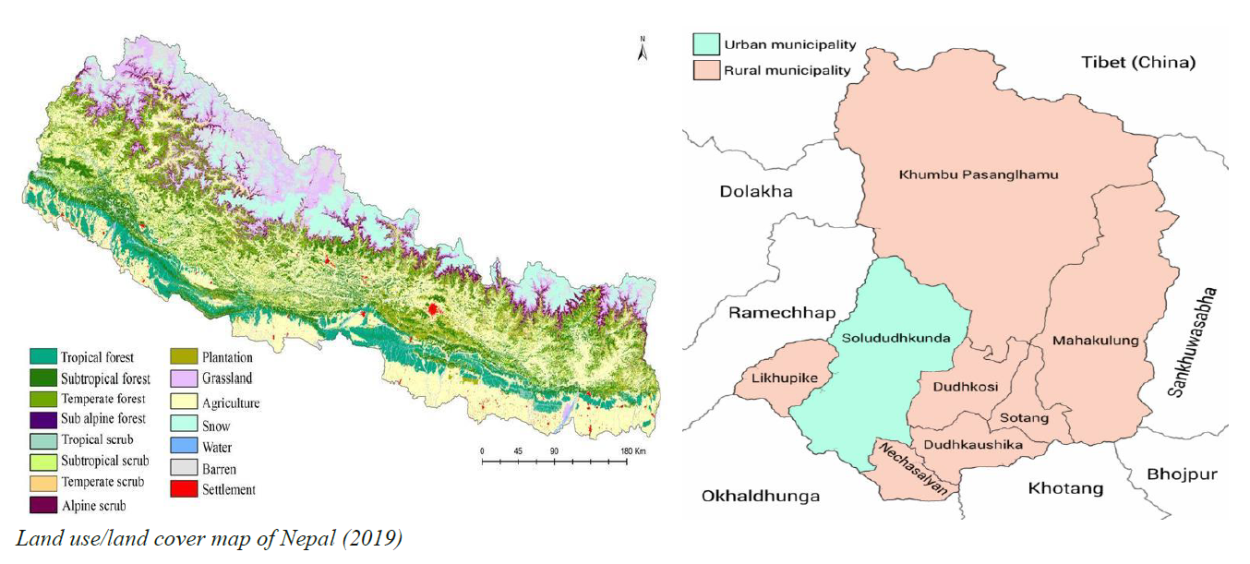
Community-based conservation is another important initiative of NINPA in Solukhumbu. The organization has been working with Indigenous Peoples and local communities to establish community-managed conservation areas. These areas are managed by the community for conservation purposes and are used for activities such as wildlife monitoring, habitat restoration and ecotourism. By promoting community-based conservation, NINPA is helping to ensure that Indigenous Peoples and local communities are invested in the conservation of the area’s unique biodiversity and cultural heritage. The establishment of community-managed conservation areas also provides opportunities for ecotourism, which can provide additional income for Indigenous Peoples and local communities.
NINPA’s work in Solukhumbu is promoting sustainable land use practices and conservation while improving the livelihoods of Indigenous Peoples and local communities. By conserving Solukhumbu’s unique biodiversity and cultural heritage, NINPA is contributing to the achievement of the Kunming-Montreal Global Biodiversity Framework’s goals of protecting and restoring ecosystems and enhancing the benefits they provide to people.
In addition to NINPA’s work, other organizations are also working to promote sustainable land use practices and conservation in Solukhumbu. However, the region still faces several challenges related to sustainable land use and conservation. One major challenge is the lack of government support for sustainable land use practices and conservation initiatives. Additionally, the region faces challenges related to the unsustainable use of natural resources, such as the illegal harvesting of medicinal plants and the overgrazing of pastures.
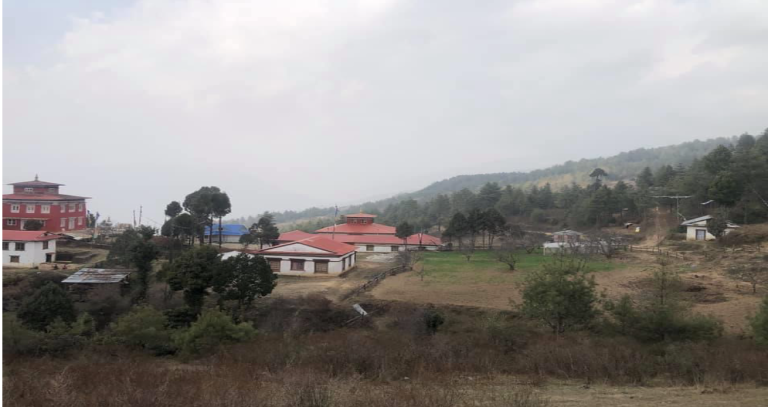
To address these challenges, it is important to promote policies that support sustainable land use practices and conservation initiatives. This can include policies that provide incentives for farmers to adopt agroforestry practices or that provide a small grant for community-based conservation initiatives. It is also important to promote education, capacity building, and awareness-raising initiatives to help Indigenous Peoples and local communities understand the importance of sustainable land use practices and conservation.
The scope of this case study
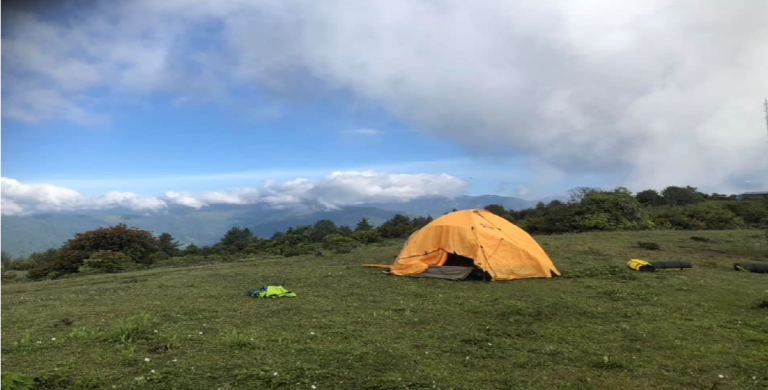
The scope of this case study includes:
- Understanding the biodiversity of the Solukhumbu region of Nepal, its ecological importance, and the threats it faces from unsustainable land use practices and uncontrolled tourism activities.
- Examining the concept of sustainable land use practices, including agroforestry, conservation agriculture, and sustainable tourism practices, and their benefits in conserving biodiversity and promoting sustainable development.
- Analyzing the potential of a community-based conservation approach for promoting biodiversity conservation and sustainable development in the Solukhumbu region of Nepal.
- Examining the potential of ecotourism for promoting sustainable development while minimizing negative impacts on the environment, Indigenous and local communities.
- Identifying the challenges faced in promoting sustainable development in the Solukhumbu region of Nepal, such as inadequate infrastructure, limited financial resources, and lack of awareness among local communities.
- Analyzing the impact of successful initiatives that have addressed these challenges, such as public-private partnerships, community-based natural resource management, and sustainable tourism development.
- Highlighting the implications of the case study for biodiversity conservation and sustainable development initiatives in other regions of the world.
It should be noted that the scope of this case study is not limited to the Solukhumbu region of Nepal, but can be applied to other regions facing similar challenges in promoting sustainable development while conserving biodiversity.
Ecosystem-based approaches
Ecosystem-based approaches can lead to improved community resilience and economies.
I. Introduction
The Solukhumbu case study focuses on conserving and revitalizing Socio-Ecological Production Landscapes and Seascapes (SEPLS) in the Solukhumbu district of Nepal. The case study highlights the efforts of local communities, NGOs, and government agencies to promote sustainable natural resource management practices and preserve the traditional way of life in the region.
Location and Context:
Solukhumbu district is located in the eastern region of Nepal, bordering China (Tibet) to the north. The district covers an area of approximately 3,312 square kilometers and has a population of around 121,000 people. The region is known for its stunning natural beauty, including Mount Everest, Lhotse, Nupse, Amadablam, Thamserku, and the Sagarmatha National Park.
II. Importance of the case study for SEPLS conservation and revitalization in Solukhumbu:
The Solukhumbu case study is significant for SEPLS conservation and revitalization because it showcases the successful implementation of sustainable natural resource management practices in a remote and ecologically sensitive area. The case study provides valuable insights into the challenges and opportunities associated with SEPLS conservation in the context of Nepal and highlights the importance of community participation and traditional knowledge in preserving SEPLS. By documenting the efforts of local communities, NGOs, and government agencies, the Solukhumbu case study can serve as a model for similar conservation initiatives in other regions of Nepal and beyond.
III. Objectives
The objectives of the Solukhumbu case study are to:
- Document community-led efforts and approaches for the conservation and revitalization of SEPLS in Solukhumbu.
- Identify the challenges faced by the community in conserving and revitalizing SEPLS and the strategies adopted to overcome them.
- Analyze the impact of community-led conservation efforts on biodiversity, ecosystem services, and human well-being in the region.
- Showcase the role of traditional ecological knowledge and modern science in promoting innovations in SEPLS conservation and management.
- Share the lessons learned from the Solukhumbu case study with IPSI members and other stakeholders for replication and upscaling in other regions.
IV. Methodology:
The methodology for this case study involved a combination of qualitative research methods, including semi-structured interviews with key stakeholders, focus group discussions with local communities, and a review of relevant literature and policy documents. The semi-structured interviews were conducted with Local government officials, NGOs, and community members involved in SEPLS conservation and revitalization activities in Solukhumbu. The focus group discussions were held with community members in different villages within the region to gain a deeper understanding of their perspectives on SEPLS conservation and their experiences with local initiatives. The literature review included academic articles, policy documents, and reports related to SEPLS conservation and revitalization in Nepal, as well as broader literature on SEPLS conservation and management.
The data collected through these methods were analyzed using thematic analysis. The themes that emerged from the data analysis were then used to develop the case study report. The report includes a description of the context, objectives, activities, and achievements of SEPLS conservation and revitalization initiatives in Solukhumbu, as well as key challenges and lessons learned. The report also highlights the importance of the Satoyama Initiative framework in guiding SEPLS conservation and revitalization efforts in the region.
V. Description of the methods used to collect data and information
The methods used to collect data and information in this case study included semi-structured interviews, focus group discussions, and a literature review.
Semi-structured interviews:
Semi-structured interviews were conducted with key stakeholders involved in SEPLS conservation and revitalization activities in Solukhumbu. These stakeholders included Local government leaders, NGOs, and community members. The interviews were designed to elicit their perspectives on SEPLS conservation and revitalization activities, including the challenges faced and lessons learned. The interviews were semi-structured, meaning that while the interviewer had a set of questions to guide the conversation, they allowed for flexibility and follow-up questions to explore specific topics in more detail.
Focus group discussions:
Focus group discussions were conducted with 350 local community members in different villages within Solukhumbu. The discussions were moderated by trained facilitators and covered a range of topics related to SEPLS conservation and revitalization, including the impact of these activities on their livelihoods and the challenges faced in implementing them. The focus group discussions provided an opportunity for community members to share their experiences and perspectives with each other and the facilitators.
Literature review:
A review of relevant literature and policy documents related to SEPLS conservation and revitalization in Nepal was conducted. The review included academic articles, policy documents, and reports related to SEPLS conservation and revitalization in Nepal, as well as broader literature on SEPLS conservation and management. This helped to provide a broader context for the case study and to identify best practices and challenges faced by other regions.
The methods used to collect data and information in this case study included semi-structured interviews, focus group discussions, and a literature review.
Semi-structured interviews were conducted with key stakeholders involved in SEPLS conservation and revitalization activities in Solukhumbu. These stakeholders included Local government officials, NGOs, and community members. The interviews were designed to elicit their perspectives on SEPLS conservation and revitalization activities, including the challenges faced and lessons learned. The interviews were semi-structured, meaning that while the interviewer had a set of questions to guide the conversation, they allowed for flexibility and follow-up questions to explore specific topics in more detail. The data collected from these interviews were analyzed thematically to identify common themes and patterns in stakeholders’ responses. The insights gained from the interviews helped to provide a deeper understanding of the community-led efforts and approaches for SEPLS conservation and revitalization in Solukhumbu.
Semi-structured interviews were conducted with key stakeholders involved in SEPLS conservation and revitalization activities in Solukhumbu. These stakeholders included government officials, NGOs, and community members. The interviews were designed to elicit their perspectives on SEPLS conservation and revitalization activities, including the challenges faced and lessons learned. The interviews were semi-structured, meaning that while the interviewer had a set of questions to guide the conversation, they allowed for flexibility and follow-up questions to explore specific topics in more detail. The data from the interviews were recorded and transcribed for analysis.
Data analysis
Data analysis:
The data collected through semi-structured interviews and focus group discussions were analyzed using thematic analysis. The themes that emerged from the analysis were used to develop the case study report.Thematic analysis involves identifying patterns and themes in the data and interpreting them to gain a deeper understanding of the phenomenon being studied. The analysis allowed for the identification of common themes across the different stakeholder groups and communities.
In summary, the methods used to collect data and information in this case study were carefully chosen to provide a comprehensive understanding of SEPLS conservation and revitalization activities in Solukhumbu. The use of semi-structured interviews and focus group discussions allowed for a deeper exploration of stakeholder perspectives and experiences, while the literature review helped to provide a broader context and identify best practices and challenges faced by other regions. The data collected were analyzed using thematic analysis to identify common themes and patterns across the different data sources.
Data Analysis Method:

Description of the sources of data and information
The sources of data and information in this case study were semi-structured interviews, focus group discussions, and a literature review.
Semi-structured interviews:
The semi-structured interviews were conducted with key stakeholders involved in SEPLS conservation and revitalization activities in Solukhumbu. These stakeholders included government officials, NGOs, and community members. The interviews were designed to elicit their perspectives on SEPLS conservation and revitalization activities, including the challenges faced and lessons learned. The information gathered from the interviews provided valuable insights into the various perspectives of stakeholders involved in SEPLS conservation and revitalization.
Focus group discussions:
The focus group discussions were held with Indigenous Peoples and local communities in different villages within Solukhumbu. The discussions were moderated by trained facilitators and covered a range of topics related to SEPLS conservation and revitalization, including the impact of these activities on their livelihoods and the challenges faced in implementing them. The information gathered from the focus group discussions provided valuable insights into the experiences and perspectives of community members who are directly impacted by SEPLS conservation and revitalization activities.
Literature review:
The literature review included academic articles, policy documents, and reports related to SEPLS conservation and revitalization in Nepal, as well as broader literature on SEPLS conservation and management. The sources were carefully selected to provide a comprehensive understanding of SEPLS conservation and revitalization activities in Solukhumbu and to identify best practices and challenges faced by other regions. The information gathered from the literature review helped to provide a broader context for the case study and to identify gaps in the existing knowledge base.
The sources of data and information in this case study were carefully chosen to provide a comprehensive understanding of SEPLS conservation and revitalization activities in Solukhumbu. The use of multiple sources, including semi-structured interviews, focus group discussions, and literature review,provided a rich and diverse set of data and information. The information gathered from the different sources was analyzed using thematic analysis to identify common themes and patterns, providing a comprehensive understanding of SEPLS conservation and revitalization activities in Solukhumbu.
Results and Achievements
Here are some potential results and achievements related to the importance of the case study for SEPLS conservation and revitalization of Solukhumbu:
Increased Awareness: One of the major achievements of the case study is the increased awareness it has brought to the importance of conserving and revitalizing the Solukhumbu region’s SEPLS. The case study has helped to raise awareness among Indigenous Peoples and local communities, Local government officials, and other stakeholders about the value of SEPLS in promoting sustainable development and preserving natural resources.
Policy Change: The case study has also led to policy changes that promote the conservation and revitalization of SEPLS in Solukhumbu. For example, the local government has introduced policies and programs that encourage the use of traditional ecological knowledge and practices in managing SEPLS.
Community Empowerment: Another achievement of the case study is the empowerment of Indigenous Peoples and local communities in Solukhumbu. The case study has helped to build local capacity and foster community-led initiatives that support SEPLS conservation and revitalization. This includes initiatives such as community forestry, watershed management, and agroforestry.
Improved Livelihoods: The conservation and revitalization of SEPLS in Solukhumbu have also led to improved livelihoods for local communities. By promoting sustainable agriculture and ecotourism, SEPLS conservation has provided new economic opportunities that benefit both people and the environment.
Environmental Benefits: Finally, the case study has demonstrated the environmental benefits of SEPLS conservation and revitalization. By promoting biodiversity, soil conservation, and water resource management, SEPLS conservation has helped to maintain healthy ecosystems that support both wildlife and people.
The case study on SEPLS conservation and revitalization in Solukhumbu has had a significant impact on promoting sustainable development and preserving natural resources. Through increased awareness, policy changes, community empowerment, improved livelihoods, and environmental benefits, the case study has demonstrated the importance of SEPLS conservation and revitalization for the long-term well-being of both people and the planet.
Lessons Learned
Some potential lessons learned from the case study on SEPLS conservation and revitalization in Solukhumbu:
Importance of Local Knowledge: The case study highlights the importance of local knowledge and traditional practices in managing SEPLS. By recognizing and incorporating traditional ecological knowledge, it is possible to promote sustainable development that benefits both people and the environment.
Community Participation: The involvement of local communities in SEPLS conservation and revitalization is essential for success. When communities are empowered to take an active role in managing natural resources, they are more likely to be invested in their long-term preservation.
Need for Policy Support: Policy supports and government incentives are critical to promoting SEPLS conservation and revitalization. When policies are put in place that incentivize sustainable land
management practices, it becomes easier for communities to prioritize environmental conservation while also meeting their economic needs.Value of Partnerships: Partnerships between government, NGOs, and local communities can be highly effective in promoting SEPLS conservation and revitalization. By working together, stakeholders can share knowledge, resources, and expertise to achieve common goals.
Value of Partnerships: Partnerships between government, NGOs, and local communities can be highly effective in promoting SEPLS conservation and revitalization. By working together, stakeholders can share knowledge, resources, and expertise to achieve common goals.
Economic Benefits: The case study demonstrates the economic benefits of SEPLS conservation and revitalization, such as increased tourism revenue and sustainable agriculture practices. By focusing on economic benefits, it is possible to incentivize communities to prioritize environmental conservation and promote sustainable development.
The case study on SEPLS conservation and revitalization in Solukhumbu provides valuable lessons for promoting sustainable development and environmental conservation. By incorporating Traditional and local knowledge, encouraging community participation, promoting policy support, forming partnerships, and emphasizing economic benefits, it is possible to achieve both environmental and economic goals.
Conclusion
In conclusion, the case study on SEPLS conservation and revitalization in Solukhumbu, Nepal, provides a valuable example of the importance of preserving natural resources and promoting sustainable development. The case study highlights how the conservation and revitalization of SEPLS can lead to increased awareness, policy changes, community empowerment, improved livelihoods, and environmental benefits. By preserving and revitalizing SEPLS, the case study shows how it is possible to achieve both economic and environmental goals, and demonstrates the value of SEPLS conservation for both people and the environment.
Additionally, the case study emphasizes the importance of Indigenous and local knowledge and community participation in achieving environmental and economic sustainability. The case study also highlights the need for policy support, partnerships, and economic benefits to achieving sustainable development in Solukhumbu and beyond. By implementing these lessons, it is possible to promote sustainable development and environmental conservation in other areas as well.
The case study underscores the urgent need for action to address environmental challenges facing our planet, including the conservation and revitalization of SEPLS. By preserving our natural resources, we can ensure that future generations have access to the same environmental benefits that we enjoy today. Therefore, it is crucial to promote sustainable practices that balance economic development with environmental conservation, and the Solukhumbu case study provides a valuable example of how this can be achieved.
Acknowledgment
Thank you to the entire local community who generously shared their knowledge and experiences without hesitation. We also acknowledge the contributions of Local government officials, conservation organizations, and researchers who have worked collaboratively to address the challenges faced in promoting sustainable development in the Solukhumbu region of Nepal. Your dedication and commitment to this cause are essential for preserving the region’s unique cultural and natural heritage for future generations.
References
Koirala, M., & Subedi, N. (2019). Challenges and Opportunities for Biodiversity Conservation in Solukhumbu District, Nepal. Journal of Biodiversity and Environmental Sciences, 14(4), 83-90.
Maharjan, R., & Joshi, N. P. (2019). Promoting Sustainable Tourism Development in the Solukhumbu Region of Nepal: Challenges and Opportunities. Journal of Tourism and Cultural Change, 17(1), 43-56 Annexes: This section may include additional information, such as maps, tables, figures, or photographs, to support the findings and conclusions of the case study.
Sharma, R., Poudel, S., & Rana, B. (2018). Land Use Change Detection and Its Impact on Biodiversity Conservation in Solukhumbu District of Nepal. Journal of Environmental Protection, 9(12), 1441-1456.
Bhatta, L. D., & Aryal, K. P. (2021). Agroforestry Practices and Their Impacts on Soil Quality and Biodiversity Conservation: A Case Study from Solukhumbu District, Nepal. Forests, 12(6), 690.
Bajracharya, B., & Schmidt-Vogt, D. (2018). Community-Based Conservation in the Solukhumbu Region of Nepal: Local Participation and Benefits. Journal of Environmental Management, 206, 716-725.
Nepal, S. K., & Shrestha, B. B. (2019). Ecotourism for Biodiversity Conservation and Sustainable Development in the Solukhumbu Region of Nepal. Journal of Ecotourism, 18(1), 21-37.
Bajracharya, B., & Schmidt-Vogt, D. (2018). Community-Based Conservation in the Solukhumbu Region of Nepal: Local Participation and Benefits. Journal of Environmental Management, 206, 716-725.
Sharma, R., Poudel, S., & Rana, B. (2018). Land Use Change Detection and Its Impact on Biodiversity Conservation in Solukhumbu District of Nepal. Journal of Environmental Protection, 9(12), 1441-1456.
Annexes
